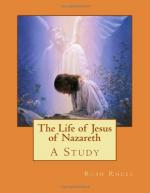238. In nothing is Jesus’ ease in handling deepest truth more apparent than in his use of irony and hyperbole in his illustrations. In his reference to the Pharisees as “ninety and nine just persons which need no repentance” (Luke xv. 7), and in his question, “Many good works have I shewed you from the Father, for which of these works do you stone me?” (John x. 32), the irony is plain, but not any plainer than the rhetorical exaggeration of his accusation against the scribes, “You strain out a gnat and swallow a camel” (Matt, xxiii. 24), or his declaration that “it is easier for a camel to go through a needle’s eye than for a rich man to enter into the kingdom of God” (Mark x. 25), or his charge, “If a man cometh unto me and hateth not his own father and mother ... he cannot be my disciple” (Luke xiv. 26). The force of these statements is in their hyperbole. Only to an interpretation which regards the letter above the spirit can they cause difficulty. In so far as they remove Jesus utterly from the pedantic carefulness for words which marked the scribes they are among the rare treasures of his teachings. The simple spirit will not busy itself about finding something that may be called a needle’s eye through which a camel can pass by squeezing, nor will it seek a camel which could conceivably be swallowed, nor will it stumble at a seeming command to hate those for whom God’s law, as emphasized indeed by Jesus (Mark vii. 6-13), demands peculiar love and honor. The childlike spirit which is heir of God’s kingdom readily understands this warning against the snare of riches, this rebuke of the hypocritical life, and this demand for a love for the Master which shall take the first place in the heart.




